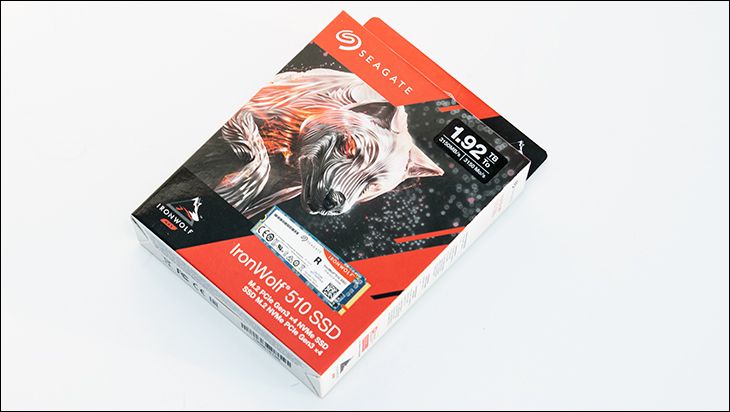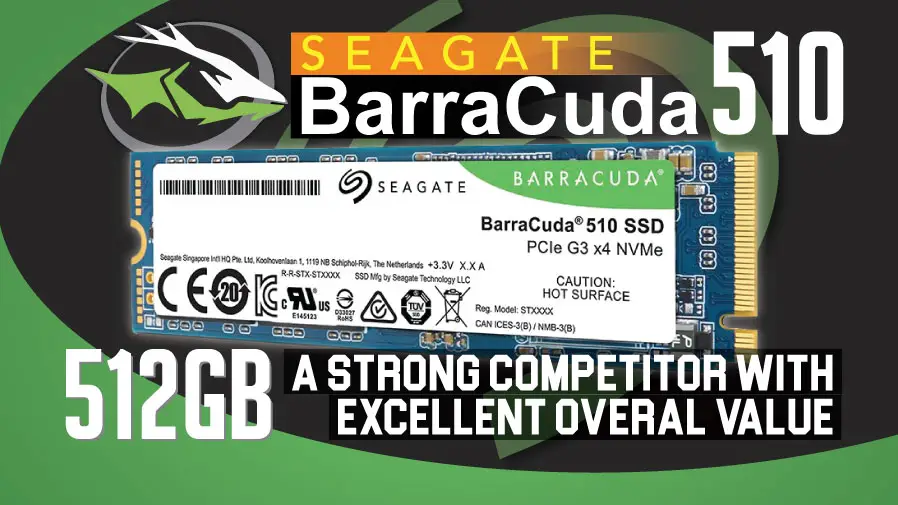
While the image and wording may be different, Seagate does use the same shipping container for basically all their Guardian Series NVMe M.2 drives. That is to say it is a colorful, if a bit over the top for our conservative tastes, box that will grab and hold people’s attention when placed on store shelves.

The accessories and internal protection configuration are also the same. For accessories, expect to find an installation pamphlet and nothing else included. However, you can (and really should) download Seagate’s SeaTools software application as well as their branded version of Acronis TI HD. Both of which easily justify the bandwidth. The internal protection consists of a multi-section, multi-part ‘clamshell’ plastic container that ensures the IronWolf 510 cannot bounce around in the relatively large cardboard box, while also absorbing a good bit of blunt for trauma before any is passed on to the relatively fragile M.2 drive. Mix in a small ESD bag and this is a setup that should survive pretty much any of the usual levels abuse that shipping agents dish out on to your precious cargo while in their… ‘tender loving care’.

Moving on. Let’s start with the easiest part and go over what has not been changed from the standard Guardian 510’s blueprint. First, as you can see the Seagate IronWolf 510 1.92TB is indeed a PCIe 3.0×4 M.2 2280… as all 2TB and smaller 510’s are 22mm wide, 80mm long M.2 drives. This includes the IronWolf 510. This is a good thing from a compatibility point of view, but not so much from a heat shedding / thermal limiting point of view… as none of them come with heatsinks and a longer 22110 PCB would have given more room for more NAND ICs, and thus surface area for passive cooling.

Also like all 510 models (as we are going to call the non-IronWolf variants for brevity’s sake), the larger capacity versions of the IronWolf 510 are all going to be double sided drives with NAND and RAM cache ICs on both sides. They are also all going to use Toshiba/Kioxia BiCS 3, 64-layer Toggle Mode 2.0 TLC NAND ICs. With 1.92TB capacity model, this means two 1GB SKhynix DDR4-2666 RAM ICs (model number H5AN8G8NCJR-VKC) for a total of 2GB of onboard cache, and four highly stacked NAND ICS with a total raw capacity if 2TB – as the difference in seen capacity comes from more over-provisioning given to the IronWolf 510 vs. the typical 510 models.
Annnnnnd that is about all the IronWolf 510 shares in common with its other Guardian 510-series brethren. In many ways, the easiest way to describe the numerous changes are to simply point to the IronWolf 125 and IronWolf 125 Pro models as a guide to what Seagate does in order to create a device meant for serious, and heavy, NAS centric workloads. To be a bit more precise there are two ‘obvious’ changes and one not so obvious change that Seagate did in order to create this extremely robust NVMe drive.

The first is the controller. While the other 510s all use Phison’s “E12” (PS5012-E12) controller, the IronWolf 510 uses Phison’s “E12DC” (PS5012-E12DC). The E12DC is Phison’s Enterprise grade NVMe controller with firmware that prioritizes long term performance consistency over short-term ‘peak’ performance, and prizes data reliability above all else. Thus the ‘DC’ or ‘Data Center’ addition to the name.
In order to create the DC variant of the E12 controller Phison starts with the same 8-channel, quad core (dual core, 32-bit ARM Cortex-R5’s + dual ‘CoXProcessor 2.0” co-processors) but massively tweaks things from there to meet the demands of the enterprise market. Many of the low-level tweaks Phison (and Seagate) are mum on, but what is known is that in addition to the “LDPC version 3 ECC engine” which can seamlessly correct up to 160bits (out of a 256KB data chunk) via its integrated hardware decoder, and upwards of 400bits (out of a 2K data chunk) via firmware, the data itself is checksum’ed and verified at every stage of the process from getting to the controller to hitting the RAM to hitting the NAND. Then it is verified on the NAND. Then and only then does the controller tell the OS that it has completed the write request. This is a much more time, and controller cycle, intensive process and rather different from the laissez faire approach home user controllers use (including the standard E12 controller). Basically, with home orientated controller’s the data is said to have been written the moment the controller accepts the data packets… and if the power goes out before it actually is fully written to the NAND… well the OS does not know it never arrived and you can end up with corrupted data.

On top of this change, and bringing us to number two change, is the DC variant of the E12 also adds in a hardware level of data protection in the case of unexpected power loss. Yes, unlike the vast, vast majority of M.2 drives the IronWolf 510 somehow found room on its itty-bitty PCB for enough super-capacitors to ensure that any in-flight data is securely written and not corrupted if the power to the system is unexpectedly lost. Very, very few Solid State Drives (even Add In Card and 2.5-inch form-factor models) come with this feature as it is both expensive and time consuming to build.

As we went over in the IronWolf 125 review, the third change is not obvious as it is has to do with the firmware. Forget about just changes in what queue depth (shallow vs. deep) or file size (small vs large) the controller’s firmware is optimized for, the IronWolf 510 also changes up exactly how data is written to the drive. This is because the IronWolf 510 boasts Seagate’s DuraWrite technology (which grew out of their SandForce IP acquisition). DuraWrite means that all data is compressed before it is written to the NAND. The actual amount of compression will vary from data block to data block, but this compression does a few key things. The first is that as more of the drive’s capacity is ‘seen’ as being used the more over-provisioning it actually will have. Remember, before a NAND block can be reused for new writes, it has to be erased and then and only then can it be written to. The more free blocks in a ‘virgin state’ there are available, the longer a drive can sustain 100 percent I/0 demands before slowing down. This in conjunction with an extra 80GB’s worth set aside for Over-Provisioning means this drive can be hammered before ever slowing down and can spread the load out over more NAND resulting in longer lived NAND cells.
The downside to DuraWrite is that while the E12DC is technically rated for TCG Opal encryption… Seagate has not implemented it. They felt that the combination of real-time compression/decompression with real-time encryption/decryption was too much for the controller to handle without needless (and random) IOPS performance dips.
The other major tweak to the firmware is precisely how fast the controller accepts new write requests. With typical SSD’s the controller basically goes flat-out accepting as much as it can right up until its RAM buffer and all its virgin NAND blocks are used. Then and only then will it slow down on accepting new write requests. Considering few home users, or even workstation users for that matter, constantly hammer a drive the amount of idle time is more than long enough for the drive to recover and be ready for the next short data burst to come its way. However, if you saturate the buffer and the OP’s ready to go free blocks… performance plummets. This is why you see ‘up to’ used in performance ratings with consumer (and even many S/MB) orientated drives.

The IronWolf 510 does not do things this way. Seagate knows the extra processor cycles dedicated towards compression and data verification are going to slow things down but they also tweaked the firmware so that writes never exceed what the NAND and controller can do under sustained loads. Yes, this means that short-term performance is going to be lower than the ‘other way’ of doing things, but it not only ensures the NAND is going to be cooler running, and longer lived… it allows them to give a minimum performance guarantee for the IronWolf 510 variants. In testing the 1.92TB typically cruised along in the 1000MB/s to 960MB/s range and really only dips down to its 850MB/s write rating when hammered for extended periods of time. Reads on the other hand are not impacted in the slightest and for all intents and purposes what you would expect from 2TB FireCuda 510 is what a 1.92TB IronWolf 510 will also deliver.
These are all major changes. Changes that mean the IronWolf 510 is meant for harshest of harsh scenarios. Scenarios that typically eat NAND based drives so fast that even Angel’s fear to tread… and not your typical home PC scenario. So, if you are serious about your data and prioritize predictability over shear speed the IronWolf 510 may indeed be right for you. Before you rush out to buy one, let’s go over precisely how big a sacrifice on the speed side of things you will have to make in order to get all that.











